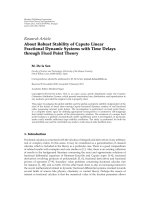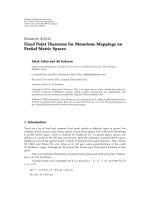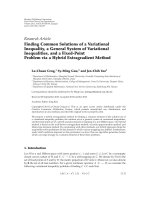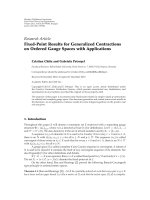Báo cáo hóa học: "Research Article Fixed Wordsize Implementation of Lifting Schemes" ppt
Bạn đang xem bản rút gọn của tài liệu. Xem và tải ngay bản đầy đủ của tài liệu tại đây (758.35 KB, 5 trang )
Hindawi Publishing Corporation
EURASIP Journal on Advances in Signal Processing
Volume 2007, Article ID 13754, 5 pages
doi:10.1155/2007/13754
Research Article
Fixed Wordsize Implementation of Lifting Schemes
Tanja Karp
Department of Electrical and Computer Engineering, College of Engineering, Texas Tech University,
P.O. Box 43102, Lubbock, TX 79409-3102, USA
Received 16 December 2005; Revised 29 May 2006; Accepted 26 August 2006
Recommended by Soontorn Oraintar a
We present a reversible nonlinear discrete wavelet transform with predefined fixed wordsize based on lifting schemes. Restricting
the dynamic range of the wavelet domain coefficients due to a fixed wordsize may result in overflow. We show how this overflow
has to be handled in order to maintain reversibility of the transform. We also perform an analysis on how large a wordsize of
the wavelet coefficients is needed to perform optimal lossless and lossy compressions of images. The scheme is advantageous to
well-known integer-to-integer transforms since the wordsize of adders and multipliers can be predefined and does not increase
steadily. This also results in significant gains in hardware implementations.
Copyright © 2007 Tanja Karp. This is an open access article distributed under the Creative Commons Attribution License, which
permits unrestricted use, distribution, and reproduction in any medium, provided the original work is properly cited.
1. INTRODUCTION
Lifting schemes have been introduced by Daubechies and
Sweldens as a structure to design and implement the discrete
wavelet transform (DWT) [1]. They have gained immense
popularity, since they provide an elegant means to maintain
perfect reconstruction of the DWT while staying in the field
of integer numbers [2], thus allowing for lossless coding. At
each lifting step, a quantizer that ensures that intermediate
results are rounded to integer numbers is introduced.
Lifting schemes have been applied to a variety of fields.
They are used to implement the polyphase filters of modu-
lated filter banks [3], are building blocks of integer-to-integer
transforms such as the IntFFT [4], the IntDCT [5], and
YCoCg-R color space transform [6]. More recently , the con-
cept of lifting has been extended to multidimensional inputs
[7]. Lifting schemes can even be designed in such a way that
they preserve signal symmetries, a fact that is important for
image compression. The performance of nonlinear reversible
DWT using lifting schemes has been studied in [8].
While keeping the wordlength of the wavelet coefficients
finite is a necessary condition for lossless coding, the dy-
namic of the signal and thus its wordlength normally in-
crease. This is not only disadvantageous from a compression
point of view, but also means a higher complexity of the cir-
cuitry. For example, in an FPGA, the number of g a tes needed
for a multiplier increases significantly with the wordlength.
It is therefore of interest to keep the maximum wordsize lim-
ited, thus resulting in a fixed-point implementation of the
lifting scheme, where, in addition to rounding, overflow oc-
curs if a value exceeds the range of representable numbers.
In this paper, we show that lifting schemes are also ro-
bust towards overflow if it is handled as wrap-around and we
evaluate the performance of fixed wordsize lifting schemes.
2. FIXED WORDSIZE LIFTING
A typical lifting step and its inverse can be described in a
matrix form as
Z
y
0
(n)
Z
y
1
(n)
=
1 A(z)
01
·
Z
x
0
(n)
Z
x
1
(n)
,
⎡
⎣
Z
x
0
(n)
Z
x
1
(n)
⎤
⎦
=
1 −A(z)
01
·
Z{y
0
(n)}
Z
y
1
(n)
,
(1)
where Z
{x( n)} denotes the z transform of a sequence x(n)
and A(z) is an FIR filter. For integer-to-integer lifting, the
output sequence of the filter A(z) is rounded to be an integer.
For a fixed wordsize implementation, we additionally need to
take care of overflow, in case the result exceeds the dynamic
range defined by the wordsize. Overflow can occur at each
multiplication and each addition during the lifting step. For
reasons of simplicity, let us first look at the case where the fil-
ter A(z) simplifies to a constant, that is, A(z)
= a. The round-
ing and overflow operations for the lifting and inverse lifting
steps are shown in Figure 1. Overflow needs to be handled at
2 EURASIP Journal on Advances in Signal Processing
x
0
(n)
y
0
(n)
a
Round
Overflow
Overflowx
1
(n)
y
1
(n)
v(n)
+
(a)
a
Round
Overflow
Overflow
v(n)
+
x
0
(n)
x
1
(n)
(b)
Figure 1: Fixed-point implementation of a lifting step and its inverse.
the resultant of the multiplication as well as at the resultant
of the adder.
We assume that x
0
(n), x
1
(n) are finite resolution num-
bers representable with a fixed wordsize, and a is an arbi-
trary real number. It can be easily seen from Figure 1 that
x
0
(n) = x
0
(n) always holds tr ue if the same fixed-point num-
ber format is chosen for lifting and inverse lifting. The mul-
tiplication a
· x
0
(n) is implemented at both the lifting step
and the inverse lifting step since y
0
= x
0
, resulting in the
same sequence v(n) at the lifting and inverse lifting steps
as long as the same rounding rules are applied and over-
flow is handled in the same way (saturation or wrap-around)
for both schemes. If no overflow occurs during the addi-
tion y
1
(n) = x
1
(n)+v(n), then no overflow occurs dur-
ing the subtraction at the inverse lifting step and we obtain
x
1
(n) = y
1
(n) − v(n) = x
1
(n).
For overflow occurring during the addition v(n)+x
1
(n)
and the subtraction y
1
(n) − v(n), the overflow only cancels,
if it is treated as wrap-around and not as saturation. In the
following, we assume that we can represent numbers in the
range from x
min
to x
max
, including these two margins.
In saturation, numbers that are larger than x
max
or
smaller than x
min
are mapped to x
max
or x
min
,respectively.
Assuming that overflow occurs at a certain time index n
0
in
such a way that x
1
(n
0
)+v(n
0
) >x
max
yields
y
1
n
0
= saturate
x
1
n
0
+ v
n
0
= x
max
,(2)
x
1
n
0
=
y
1
n
0
−
v
n
0
=
x
max
− v
n
0
=
x
1
n
0
. (3)
Note that the result of y
1
(n
0
)−v(n
0
) always lies within the
range of representable numbers, and therefore no overflow
occurs in (3). A similar case can be made for x
1
(n
0
)+v(n
0
) <
x
min
.
In wrap-around, overflow is handled in such a way that
the amount by which a number exceeds x
max
will be added
to x
min
and the amount by which a number is smaller than
x
min
will be subtracted from x
max
. Note that wrap-around is
very similar to modulus operation and results in wrap(x +
k(x
max
− x
min
)) = x,ifk is an integer value. While overflow
error is larger in wrap-around than in saturation, it has the
advantage that the result obtained after adding a number and
then subtracting the same number is the original value even
if overflow affected the intermediate result. Thus, if x
1
(n
0
)+
v(n
0
) >x
max
,weobtain
y
1
n
0
=
wrap
x
1
n
0
+ v
n
0
= x
min
+
x
1
n
0
+ v
n
0
−
x
max
=
x
1
n
0
+ v
n
0
−
x
max
− x
min
,
x
1
n
0
= wrap
y
1
n
0
− v
n
0
= wrap
x
1
n
0
+ v
n
0
−
x
max
− x
min
−
v
n
0
= wrap
x
1
n
0
−
x
max
− x
min
= x
1
n
0
,
(4)
and if x
1
(n
0
)+v(n
0
) <x
min
,weget
y
1
n
0
= wrap
x
1
n
0
+ v
n
0
= x
max
−
x
min
−
x
1
n
0
+ v
n
0
= x
1
n
0
+ v
n
0
+
x
max
− x
min
,
x
1
n
0
=
wrap
y
1
n
0
−
v
n
0
= wrap
x
1
n
0
+ v
n
0
+
x
max
− x
min
−
v
n
0
=
wrap
x
1
n
0
+
x
max
− x
min
=
x
1
n
0
.
(5)
From the upper equations, we see that the overflow error
introduced at the lifting step is canceled at the inverse lifting
step. If we now return to the general form of lifting with A(z)
being a filter, we realize that all we have to ensure for overflow
errors to cancel is that the filter output signal v(n) is the same
for lifting and inverse lifting. Since both filters and their in-
put signals are identical, this means that we have to imple-
ment the convolution in an identical way at the lifting and
the inverse lifting steps, that is, applying the same wordsize,
using the same rounding algorithms, and treating overflow
in the same way. Note that for the overflow handling blocks
which calculate v(n), it does not matter whether we choose
saturation or wrap-around in the case of overflow, as long as
we do the same for lifting and inverse lifting.
Tan ja Ka rp 3
(a) (b)
Figure 2: Fixed-point approximation and detail coefficients in the wavelet domain (3-level decomposition) with wordsize of (a) 13 bits and
(b) 9 bits.
3. PERFORMANCE ANALYSIS
To evaluate the performance of the fixed-point lifting
scheme, we implemented Daubechies’ 9–7 wavelet using the
lifting scheme described in [1]. Each lifting step is imple-
mented according to Figure 1, where instead of a constant
a we have first-order filters. T he dual lifting step is imple-
mented accordingly. We then apply three levels of the fixed-
point wavelet transform to the 256
× 256 pixel 8-bit grey-
scale image known as “cameraman” using different fixed-
point formats and wordsizes. Image boundaries are treated
using symmetric extension [9]. Since the final scaling factor
in the lifting decomposition of the 9–7 wavelet does not per-
tain symmetry of the approximation and detail coefficients if
it is implemented as a 4-step lifting [1], it has been omitted
in our implementation. Reference [9] explains how it could
be implemented using a per-lifting-step symmetric extension
method.
In a first step, the input image is scaled such that all pixel
values lie within the range (
−1, 1), and thus can be repre-
sented by a sign bit and 7 bits describing the values after the
binary point. All lifting coefficients and intermediate signals
are realized using an identical fixed-point format. For our
analysis, we consider wordsizes with 7 bits after the binary
point (same as input) and 9 bits after the binary point to al-
low for a more accurate representation of intermediate re-
sults. The number of bits before the binary point is fixed for
each implementation. Depending on the setup, it varies from
1 ( sign bit) to 6, allowing for different dynamic ranges for
intermediate signals as well as the approximation and detail
coefficients. Overflow at the lifting step addition is treated as
wrap-around to ensure cancellation of overflow errors at the
reconstruction. Overflow within the lifting step is treated ei-
ther as wrap-around or saturation.
Figure 2 shows the wavelet coefficients of the 3-level de-
composition if 7 bits are used after the binary point, satura-
tion is applied for overflow within a lifting step, and wrap-
around is used at the adders. For Figure 2(a),weallow6bits
in front of the binary point (i.e., a total wordsize of 13 bits)
0
0.5
1
1.5
2
Compression ratio
8 9 10 11 12 13 14 15
Wordsize (bits)
Frac9, sat. and wrap
Frac9, wrap
Frac7, sat. and wrap
Frac7, wrap
Figure 3: Lossless compression using SPIHT. Wavelet coefficients
have 7 bits after the binary point (frac7) or 9 bits (frac9); the num-
ber of bits before the binary points varies.
and for Figure 2(b), we only allow 2 bits before the binary
point (i.e., a total wordsize of 9 bits).
While Figure 2(a) looks very similar to w hat we are used
to see for linear, integer-to-floating-point DWT decomposi-
tion, namely horizontal, vertical, and diagonal edge informa-
tion in the detail bands and a scaled copy of the original im-
age in the approximation band, Figure 2(b) shows large co-
efficients in the detail bands. In fact, most of the detail bands
look like an approximation of the original image. This can be
explained by the fact that handling overflow as wrap-around
turns a large positive number into a small negative number,
a nonlinear operation that produces new frequencies, result-
ing in the large number of high-frequency components seen
in the detail bands of Figure 2(b).
To examine the suitability of our fixed-point lifting
scheme for lossless compression, we have losslessly encoded
the fixed-point wavelet coefficients using SPIHT encoder
[10]. Figure 3 shows the obtained compression ratios. As
4 EURASIP Journal on Advances in Signal Processing
10
15
20
25
30
35
40
PSNR
012345
Extra bits before binary point
Lossy compression 4 : 1
Frac7, sat. and wrap
Frac9, sat. and wrap
Frac7, wrap
Frac9, wrap
(a)
10
15
20
25
30
PSNR
012345
Extra bits before binary point
Lossy compression 16 : 1
Frac7, sat. and wrap
Frac9, sat. and wrap
Frac7, wrap
Frac9, wrap
(b)
Figure 4: Lossy coding using SPIHT. Wavelet coefficients have 7 bits
after the binary point (frac7) or 9 bits (frac9); the number of bits
before the binary points varies.
expected, the scheme with 7 bits after the binary point
achieves a hig her compression ratio as the one with 9 bits,
since SPIHT can stop encoding 2-bit levels earlier. However,
the schemes with the shorter wordlength result in a poorer
compression ratio, mainly because of the large number of
significant wavelet coefficients in the detail bands. We can
observe from Figure 3 that we need a wordsize that is about
3 to 4 bits larger than the 8-bit input wordsize to obtain the
highest compression ratio. Having a larger wordsize than that
does not improve the performance any further but means
increased circuit complexity, since adders and multipliers of
larger wordsize have to be used.
Also, we see from Figure 3 that the fixed-point im-
plementation that uses saturation for the lifting filter and
wr ap-around for the addition outperforms the one that uses
wrap-around at both places. This is because saturation intro-
duces the lower overflow error of both schemes.
Figure 4 shows the PSNRs obtained when performing
lossy compression of ratios 4 : 1 and 16 : 1 using SPIHT for
the fixed-point wavelet coefficients. We notice that the PSNR
significantly reduces if less than 4 extra bits are spent before
the binary point to cover the increased dynamic of the signal.
Again, for short wordsizes, the SPIHT has to spend many bits
to encode the large number of significant detail coefficients.
For the range of 1 to 3 extra bits, the fixed-point scheme with
saturation for overflow handling at the lifting filter again out-
performs the one that used wrap-around. Also, we see that
the increased precision of the intermediate signals, lifting fil-
ter coefficients, and wavelet coefficients maintained in the
scheme with 9 bits after the binary point shows only minimal
improvement over the scheme w ith 7 bits, and thus does not
justify the increased circuitry since it also has a lower com-
pression ratio in the lossless case. Note that the low compres-
sion ratio obtained is due to the small image size.
4. APPROPRIATE CHOICE OF WORDSIZE
The results from the previous section have shown that the
performance of the compression scheme highly depends on
the wordsize chosen. From Figure 2, we have seen that over-
flow that happens when calculating the approximation co-
efficients results in a significant change of the detail coeffi-
cients and a reduced ability of SPIHT to compress the image
effectively. Since most large wavelet coefficients are in the ap-
proximation band, which shows a reduced-size thumbnail of
the original image, we have to choose the wordsize such that
overflow only happens rarely when calculating these coeffi-
cients. For Daubechies’ 9–7 wavelet, the lowpass filter ampli-
fies the amplitude by
√
2, resulting in a factor of 2 per 2D
decomposition step, and thus 1 additional bit being required
per level of decomposition. Since we did not implement the
scaling factor of 1.1496 in the lifting decomposition [1], the
gain is actually slightly lower. Figures 3 and 4 confirm that we
obtain close-to-optimal performance in terms of compres-
sion ratio for lossless compression and in terms of PSNR for
lossy compression with 3 additional bits before the binary
point if we use saturation for overflow within a lifting step.
However, from the difference in PSNR at 3 additional bits
when using wrap-around or saturation within a lifting step,
we conclude that overflow still happens during the calcula-
tions since otherwise both results should be identical. Only
at 4 additional bits the results for wrap-around and satura-
tion do converge. Thus, in addition to the general scaling of
the approximation coefficients, one needs to take interme-
diate results into account, where overflow can occur even if
the final wavelet coefficient lies within the range of realizable
numbers. For the lifting implementation of Daubechies’ 9–
7wavelet[1], the most critical step in the decomposition is
the first lifting step, where neighboring even-indexed pixels
are added and then scaled by a factor of
−1.5861, thus re-
sulting in values that have a magnitude that is 3.1723 as large
as the incoming values if those belong to a smooth region
of the image and are identical. Thus, the extra bit (4 addi-
tional bits before the binary point instead of 3) avoids major
occurrence of overflow a t this step. The other lifting steps of
Tan ja Ka rp 5
our implementation [1] have scaling factors with magnitudes
less than one and are thus of no concern.
5. CONCLUSION
Inthispaper,wehavepresentedafixedwordsizeim-
plementation of the lifting scheme that maintains perfect
reconstruction even in the case of overflow occurrences. It
provides a nonlinear, reversible, integer-to-integer discrete
wavelet transform with predefined dynamic range of the
wavelet coefficients. However, when limiting the dynamic
range of the wavelet coefficients too much, a large number
of significant detail coefficients occur due to overflow errors
and make the scheme less suitable for lossy and even loss-
less compression using standard wavelet encoding schemes.
However, as long as the wordlength is chosen such that over-
flow occurs only rarely, the scheme provides the advantage
that limited wordsize adders and multipliers can be used,
which is of particular advantage for FPGA implementations.
We have derived how the increase in wordsize depends on the
number of levels of wavelet transform that are performed as
well as the values of the lifting coefficients.
REFERENCES
[1] I. Daubechies and W. Sweldens, “Factoring wavelet transforms
into lifting steps,” Journal of Fourier Analysis and Applications,
vol. 4, no. 3, pp. 247–269, 1998.
[2] A. R. Calderbank, I. Daubechies, W. Sweldens, and B L. Yeo,
“Wavelet transforms that map integers to integers,” Applied
and Computational Harmonic Analysis, vol. 5, no. 3, pp. 332–
369, 1998.
[3] A. Mertins and T. Karp, “Modulated, perfect reconstruction
filterbanks with integer coefficients,” IEEE Transactions on Sig-
nal Processing, vol. 50, no. 6, pp. 1398–1408, 2002.
[4] S. Oraintara, Y J. Chen, and T. Q. Nguyen, “Integer fast
Fourier transform,” IEEE Transactions on Signal Processing,
vol. 50, no. 3, pp. 607–618, 2002.
[5] J. Liang and T. D. Tran, “Fast multiplierless approximations of
the DCT with the lifting scheme,” IEEE Transactions on Signal
Processing, vol. 49, no. 12, pp. 3032–3044, 2001.
[6] H. Malvar and G. Sullivan, “YCoCg-R: a color space with
RGB reversibility and low dynamic range,” ISO/IEC JTC1/
SC29/WG11 and ITU-T SG16 Q.6, July 2003.
[7] R. Geiger, Y. Yokotani, and G. Schuller, “Improved integer
transforms for lossless audio coding,” in Proceedings of the
37th Asilomar Conference on Signals, Systems and Computers
(ACSSC ’03), vol. 2, pp. 2119–2123, Pacific Grove, Calif, USA,
November 2003.
[8] J.Reichel,G.Menegaz,M.J.Nadenau,andM.Kunt,“Integer
wavelet transform for embedded lossy to lossless image com-
pression,” IEEE Transactions on Image Processing, vol. 10, no. 3,
pp. 383–392, 2001.
[9] M. D. Adams and R. K. Ward, “Symmetric-extension-
compatible reversible integer-to-integer wavelet transforms,”
IEEE Transactions on Signal Processing, vol. 51, no. 10, pp.
2624–2636, 2003.
[10] A. Said and W. A. Pearlman, “A new, fast, and efficient im-
age codec based on set partitioning in hierarchical trees,”
IEEE Transactions on Circuits and Systems for Video Technol-
ogy, vol. 6, no. 3, pp. 243–250, 1996.
Tan ja Ka rp received the Dipl Ing. degree
in electrical engineering (M.S.E.E.) and
the Dr Ing. degree (Ph.D.) from Hamburg
University of Technology, Hamburg, Ger-
many, in 1993 and 1997, respectively. In
1995 and 1996, she spent two months as
a Visiting Researcher at the Signal Process-
ing Department of ENST, Paris, France, and
at the Mutirate Signal Processing Group,
University of Wisconsin at Madison, respec-
tively, working on modulated filter banks. In 1997, she joined the
Institute of Computer Engineering at Mannheim University, Ger-
many, as a Senior Research and Teaching Associate. From 1998 to
1999, she has also taught as a Guest Lecturer at the Institute for
Microsystem Technology at Freiburg University, Germany. From
2000 to 2006, she was an Assistant Professor in the Department
of Electrical and Computer Engineering at Texas Tech University,
Lubbock, Texas. She is now an Associate Professor in the same de-
partment. Her research interests include multirate signal process-
ing, filter banks, audio coding, multicarrier modulation, and signal
processing for communications. She is an IEEE Member and regu-
larly reviews articles for several IEEE and EURASIP transactions.









